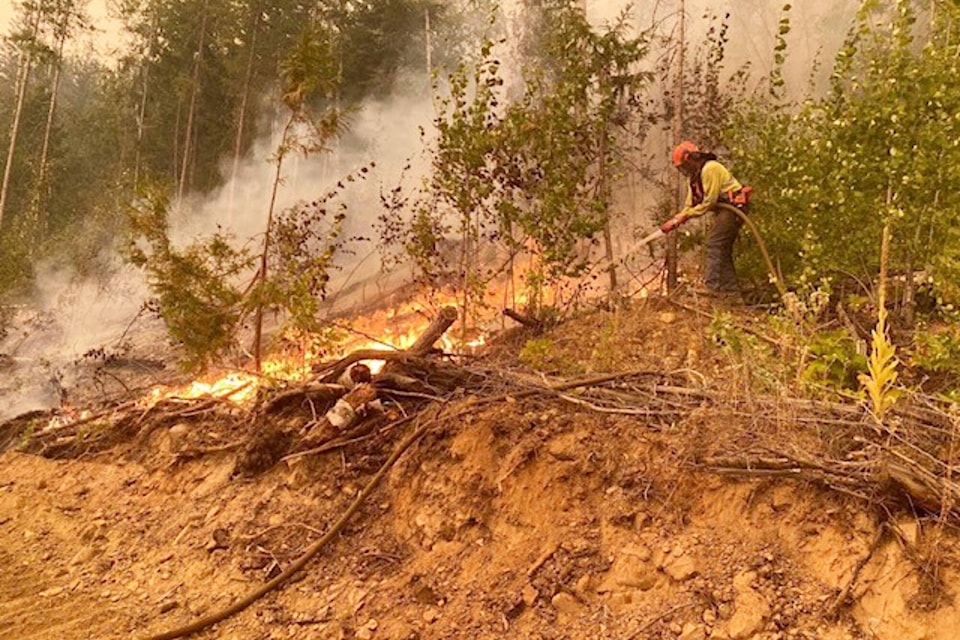While not ready to leave, Jay Simpson said he and fellow North Shuswap citizens who continue fighting fires are tired and want help.
“At this point, we’re bagged, we’ve been working 2o-hour days in more dangerous situations and so much smoke. I’ve got nothing but so much respect for people who are out there stomping on fires,” said Simpson, the Electoral Area F director with the Columbia Shuswap Regional District (CSRD).
Simpson and others continue to defy a CSRD evacuation order that’s been in place since Friday, Aug. 18, when what’s now referred to as the Bush Creek East wildfire spread into the communities of Lee Creek, Scotch Creek and Celista.
“I’m the epitome of civil disobedience right now, because I did not follow the order to depart… I stayed behind and fought the fires to save my home, my neighbours, my community…,” said Simpson, frustrated that authorities are preventing things like bottled water, food and fuel for generators from reaching citizens fighting fires in the evacuation order areas.
“There are fuel suppliers out there that would just love to stop in and help us, but they’re being piloted through so nobody gets off the road, nobody stops and drops off some fuel, nobody does anything. We can’t get a hot dog in here. We can’t get a bottle of water in here… we’re just cut right off.”
The CSRD continues to urge citizens to vacate the evacuation order areas, for their safety and the safety of firefighters.
“The message that I want to provide to the community is there are enough resources on this fire to actively engage whatever comes at them, and if there aren’t enough resources, we have resources waiting to go into the communities to deal with this,” said Shuswap Emergency Program emergency operations director Derek Sutherland in an afternoon Aug. 22 update. “So community members can feel safe and secure that there are firefighters to deal with any issues that arise on their property if and when they choose to evacuate.”
With lingering hot spots, flare ups and more, Simpson agreed it’s not a safe situation to be working in.
“It’s not a safe thing to be doing, but on the other hand we are saving our homes, our communities,” he said, acknowledging help is needed.
Simpson said he took part in a meeting Tuesday (Aug. 22) between locals and BC Wildfire Service personnel, during which a collaborative approach was discussed.
“They came out and sat down at our kitchen table, two of them, a couple of us, and they talked about how the backburn went and what they did and how we can work together, and we’re working towards that,” said Simpson. “Our contractors out here with big heavy machinery, we’re getting them registered with BC Wildfire so we can work in conjunction with them.
“We want this cooperation – it’s critical. We cannot do this ourselves. We cannot save our communities all by ourselves. We’ve taken the first three days of utter chaos and done what we could to save as much as we could, but it’s a long game, it’s going to be months, two months – until the snow flies.”
BC Wildfire Service information officer Forrest Tower said such collaborations are not uncommon, that there’s a successful one working the Rossmore Lake wildfire near Kamloops.
“We’ve had community members from Knutsford that’s engaged on that fire since July,” said Tower. “They’re folded into our operations, some of them have actually signed up with us as emergency firefighters, a large number of them have not, they’re still volunteer status. But we have a good organizational structure there, there’s clear lines of communication, there’s check-ins happening… So it can work, we just really have to work towards some good operational oversight and at this point, the BC Wildfire Service provides that operational oversight.
“Folding community members into that whenever possible will be a lot more efficient than everyone kind of running around doing their own thing, which is both unsafe and also not efficient. It just makes things take much longer.”
Tower, acknowledging the good work being done in the North Shuswap, believes better communication is needed to ease tensions and remind people they’re working towards the same goals.
“I think there’s this sense that because there’s RCMP blockages and an evacuation order and supplies aren’t getting in, that government is working against people,” said Tower. “Really, all that has to happen is if there are individuals who do have those skills and wants to put them to use, and they’re willing to work in an organized manner under direction – usually by someone with the BC Wildfire Service, they just have to reach out.”
Simpson said they were told by the BCWS that it needs locals – their expertise, equipment and knowledge of the area.
“I just had a guy from Magna Bay text me a photo of a fire that’s burning in a steep area – he gave me a pin of the location, told me there was nobody in the area, so I sent that off to BC Wildfire and they sent it off to their operations people,” said Simpson. “So locals on the ground being able to help BC Wildfire identify areas of concern and areas of large fires, flames…
“They were in and put about four hours in dual helicopters into the Lee Creek Gorge and I’m sure that will save a bunch of houses that are downstream of that area. So we love the collaboration, we’d love to have them here.”
lachlan@saobserver.net
Like us on Facebook and follow us on Twitter
Sign up for our newsletter to get Salmon Arm stories in your inbox every morning.
